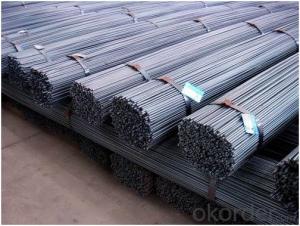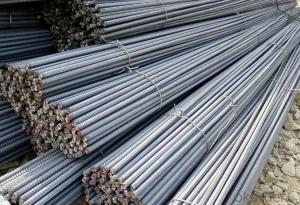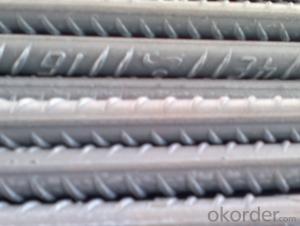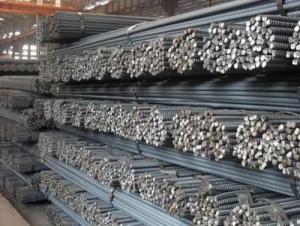Deformed Bars/ Reinforcing Steel Bars/ Rebar for Construction from China Professional Manufacturer
- Loading Port:
- Tianjin
- Payment Terms:
- TT or LC
- Min Order Qty:
- 30 m.t.
- Supply Capability:
- 40000 m.t./month
OKorder Service Pledge
OKorder Financial Service
You Might Also Like
Product Specifications of Deformed Bars/ Reinforcing Steel Bars/ Rebar for Construction from China Professional Manufacturer
1. reinforcing steel bar
2.diameter:6mm-40mm
3.length:3.5m-12m or as customized
4.certificate:ISO9001:2008,ISO14001:2004
Produt Size and Materials of Deformed Bars/ Reinforcing Steel Bars/ Rebar for Construction from China Professional Manufacturer:
(1)6mm-40mm rebar
(2)12mm-300mm round bar
(3)0.40-1.2mm*1000-1250mm*C electro galvanized steel coil
(4)0.16-1.0mm*900-1250mm*C prepainted galvanized steel coil
(5)0.15-2.0mm*900-1250mm*C hot dipped galvanized steel coil and aluzinc steel coil
(6)0.3-2.0mm*400-1400mm*C cold rolled steel coil
(7)0.80mm-2.0mm mig welding wire
The products exported to Korea, Japan and Southeast Asia, and have a good reputation.
Luli Steel Co., Ltd warmly welcomes all the customers to come to discuss the cooperation and seek common development.
If any questions and need steel information,pls feel free to contact me.
Theorectical Weight Index of Deformed Bars/ Reinforcing Steel Bars/ Rebar for Construction from China Professional Manufacturer:
Diameter (MM) | Inner Diameter (mm) | Rib height (mm) | Cross Sectional Area (MM²) | Theorectical Weight (KG/M) |
6 | 5.8 | 0.6 | 28.27 | 0.222 |
8 | 7.7 | 0.8 | 50.27 | 0.395 |
10 | 9.6 | 1.0 | 78.54 | 0.617 |
12 | 11.5 | 1.2 | 113.1 | 0.888 |
14 | 13.4 | 1.4 | 153.9 | 1.21 |
16 | 15.4 | 1.5 | 201.1 | 1.58 |
18 | 17.3 | 1.6 | 254.5 | 2 |
20 | 19.3 | 1.7 | 314.2 | 2.47 |
22 | 21.3 | 1.9 | 380.1 | 2.98 |
25 | 24.2 | 2.1 | 490.9 | 3.85 |
28 | 27.2 | 2.2 | 615.8 | 4.83 |
32 | 31.0 | 2.4 | 804.2 | 6.31 |
36 | 35.0 | 2.6 | 1018 | 7.99 |
40 | 38.7 | 2.9 | 1257 | 9.86 |
standard and grade of Deformed Bars/ Reinforcing Steel Bars/ Rebar for Construction from China Professional Manufacturer
ASTM | BS | JIS | GB |
A615 | BS4449 | G3112 | HRB |
Gr40/60/75 | Gr460, B500 | SD390 | 335/400/500 |
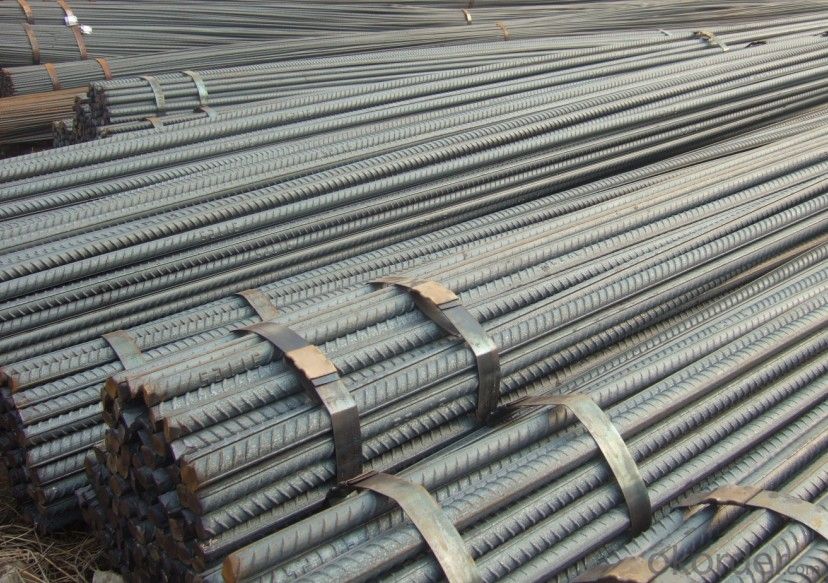
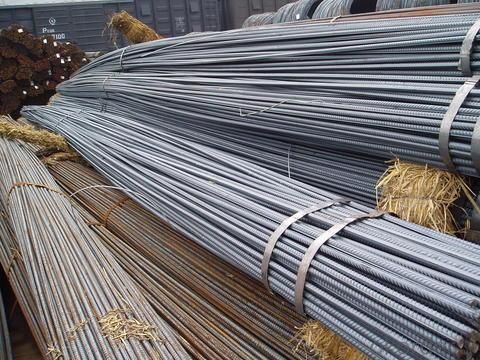
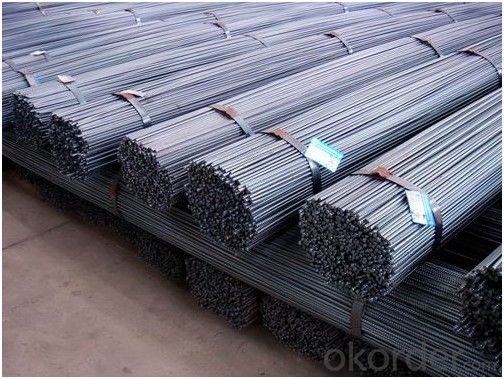
- Q:What are the different methods of connecting steel rebars?
- There are various methods of connecting steel rebars, including lap splicing, mechanical splicing, and welding. Lap splicing involves overlapping the rebars and securing them with wire or tie bars. Mechanical splicing utilizes couplers or threaded sleeves to connect the rebars. Welding involves melting the rebars together to form a strong bond. Each method has its advantages and suitability depending on the specific requirements of the construction project.
- Q:How are steel rebars protected against lightning strikes?
- Steel rebars are typically protected against lightning strikes through the implementation of lightning rods or conductive bonding systems. These systems help to divert the electrical current from lightning strikes away from the rebars and into the ground, reducing the risk of damage or corrosion caused by the high voltage.
- Q:How do steel rebars affect the overall sound insulation of a building?
- Steel rebars have minimal impact on the overall sound insulation of a building. While they may conduct sound to a small extent due to their rigid nature, the primary factors affecting sound insulation are the materials used for walls, floors, and ceilings, as well as insulation materials. Steel rebars are typically embedded within concrete structures and do not significantly contribute to sound transmission between spaces.
- Q:What are the common methods of cutting steel rebars on construction sites?
- The common methods of cutting steel rebars on construction sites include using a circular saw with an abrasive or diamond blade, a cutting torch with oxy-fuel or plasma, a hydraulic shear, or a rebar cutter.
- Q:Can steel rebars be used in port infrastructure construction?
- Yes, steel rebars can be used in port infrastructure construction. Steel rebars are commonly used in the construction industry, including for port infrastructure projects. Rebars provide strength and reinforcement to concrete structures, making them ideal for constructing durable and resilient port facilities. They help in reinforcing concrete slabs, beams, and columns, ensuring that the structures can withstand the heavy loads and constant exposure to water and other environmental factors in port areas. Additionally, steel rebars have high tensile strength, making them suitable for handling the dynamic forces experienced in port infrastructure such as wharves, piers, and docks. Overall, steel rebars are an essential component in the construction of robust and long-lasting port facilities.
- Q:Can steel rebars be cut on-site during construction?
- Yes, steel rebars can be cut on-site during construction. This process, known as rebar cutting, is commonly done to achieve the desired length or shape of the rebars to meet specific project requirements.
- Q:Are steel rebars prone to rusting?
- Steel rebars have a tendency to rust. Rebars are composed mainly of carbon steel, which contains iron. When exposed to moisture and oxygen, the iron in steel rebars undergoes a chemical reaction known as oxidation, resulting in the formation of rust or iron oxide. This process can be accelerated in environments with high humidity, coastal regions with saltwater exposure, or when the rebars come into contact with water or other corrosive substances. The rusting of steel rebars can weaken their structural integrity and compromise the strength and durability of concrete structures. Therefore, it is crucial to protect rebars from rust by applying anti-corrosion coatings or using stainless steel rebars in areas prone to rusting. Regular maintenance and inspection are also important for promptly identifying and addressing any rust-related issues.
- Q:What is the average diameter of steel rebars used in construction?
- The average diameter of steel rebars used in construction typically ranges between 6 millimeters (mm) to 40 mm. However, the specific diameter of the steel rebars may vary depending on the requirements of the construction project and the structural design. It is important to note that different countries or regions may have their own set of standards and regulations regarding the diameter and other specifications of steel rebars used in construction. Therefore, it is advisable to consult the local building codes and engineering professionals to determine the appropriate diameter of steel rebars for a specific construction project.
- Q:What is the role of steel rebars in ensuring occupant safety?
- The role of steel rebars in ensuring occupant safety is crucial as they provide strength, stability, and reinforcement to concrete structures. By reinforcing concrete with steel rebars, they enhance the structural integrity of buildings, bridges, and other infrastructure, making them more resistant to external forces such as earthquakes, heavy loads, and impacts. Steel rebars help prevent the collapse of structures, reducing the risk of injury or fatality to occupants during unexpected events or accidents.
- Q:What are the common defects found in steel rebars?
- There are several common defects that can be found in steel rebars. One common defect is surface cracks, which can occur during the manufacturing process or due to improper handling and storage. These cracks can compromise the strength and integrity of the rebars and may lead to failure under load. Another common defect is corrosion, which can occur when the rebars are exposed to moisture or chemicals. Corrosion can weaken the rebars and reduce their load-bearing capacity, making them more susceptible to failure. Bending and straightening defects are also frequently observed in steel rebars. Improper bending or straightening can lead to cracks, buckling, or uneven stress distribution, compromising the rebars' performance. Inadequate welding or improper lapping of rebars can result in poor connections and reduced structural integrity. Welding defects such as lack of fusion, incomplete penetration, or excessive porosity can weaken the rebars and increase the risk of failure. Dimensional defects, such as variations in diameter, length, or straightness, can affect the rebars' fit and compatibility with other structural components. If rebars are not properly aligned or do not meet the required dimensions, it can lead to reduced structural strength and compromised performance. Lastly, improper heat treatment during the manufacturing process can result in internal defects such as segregation, inclusions, or improper grain structure. These defects can weaken the rebars and make them more prone to fracture or failure under load. Overall, it is essential to carefully inspect steel rebars for these common defects to ensure the structural integrity and safety of the construction projects they are used in.
1. Manufacturer Overview |
|
|---|---|
| Location | |
| Year Established | |
| Annual Output Value | |
| Main Markets | |
| Company Certifications | |
2. Manufacturer Certificates |
|
|---|---|
| a) Certification Name | |
| Range | |
| Reference | |
| Validity Period | |
3. Manufacturer Capability |
|
|---|---|
| a)Trade Capacity | |
| Nearest Port | |
| Export Percentage | |
| No.of Employees in Trade Department | |
| Language Spoken: | |
| b)Factory Information | |
| Factory Size: | |
| No. of Production Lines | |
| Contract Manufacturing | |
| Product Price Range | |
Send your message to us
Deformed Bars/ Reinforcing Steel Bars/ Rebar for Construction from China Professional Manufacturer
- Loading Port:
- Tianjin
- Payment Terms:
- TT or LC
- Min Order Qty:
- 30 m.t.
- Supply Capability:
- 40000 m.t./month
OKorder Service Pledge
OKorder Financial Service
Similar products
New products
Hot products
Hot Searches
Related keywords
